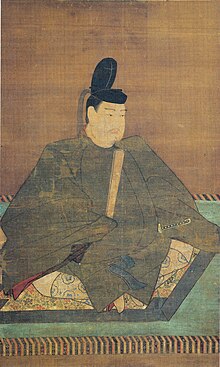Emperor Shōmu
| Shōmu | |
|---|---|
| Emperor of Japan | |
 |
|
| Reign | March 3, 724 – August 19, 749 |
| Predecessor | Genshō |
| Successor | Kōken |
| Born | 701 |
| Died | June 4 756 Nara, Japan |
| Burial | Sahoyama no minami no misasagi (Nara) |
| Spouse | Fujiwara no Asukabe-hime(Kōmyō) (701–760) |
| Issue | Prince Motoi, Kōken, Prince Asaka, Princess Inoe, Princess Fuwa |
| Father | Monmu |
| Mother | Fujiwara no Miyako (?–754), daughter of Fujiwara no Fuhito |
Emperor Shōmu (聖武天皇 Shōmu-tennō?, 701 – June 4, 756) was the 45th emperor of Japan, according to the traditional order of succession.
Shōmu's reign spanned the years 724 through 749.
Before his ascension to the Chrysanthemum Throne, his personal name (imina) is not clearly known, but he was known as Oshi-hiraki Toyosakura-hiko-no-mikoto.
Shōmu was the son of Emperor Monmu and Fujiwara no Miyako, a daughter of Fujiwara no Fuhito.
Shōmu had four Empresses and six Imperial sons and daughters.
Shōmu was still a child at the time of his father's death; thus, Empresses Gemmei and Gensho occupied the throne before he acceded.
Shōmu continued to reside in the Hezei Palace.
Shōmu is known as the first emperor whose consort was not born into the imperial household. His consort Kōmyō was a non-royal Fujiwara commoner. A ritsuryō office was created for the queen-consort, the Kogogushiki; and this bureaucratic innovation continued into the Heian period.
While battle maneuvers of the Fujiwara no Hirotsugu Rebellion were still underway, in Tenpyō 12 10th month (November, 740) Emperor Shōmu left the capital at Heijō-kyō (Nara) and traveled eastward via Horikoshi (堀越頓宮; today Tsuge; 10th month, 29th day: November 22), Nabari (10th month, 30th day: November 23), Ao (安保頓宮; today Aoyama ; 11th month 1st day: November 24) to Kawaguchi in Ichishi District, Ise Province (today part of Tsu, formerly part of Hakusan) where he retreated together with his court to a temporary palace. One of his generals was left in command of the capital. Presumably Shōmu feared Fujiwara supporters in Nara and was hoping to quell potential uprisings in other parts of the country with his presence. After four days travelling through heavy rain and thick mud, the party reached Kawaguchi on Tenpyō 12 11th month, 2nd day (25 November, 740) A couple of days later, they learn of Hirotsugu's execution and that the rebellion had been quelled.
...
Wikipedia
